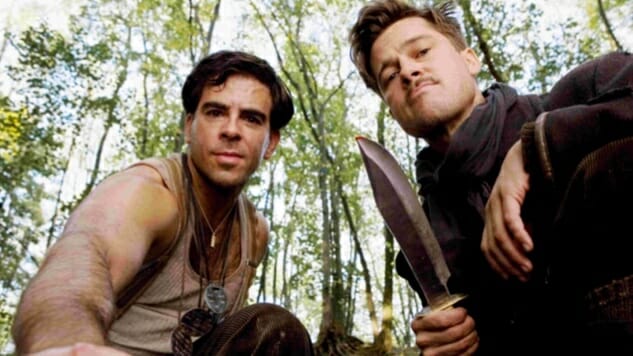
You know somethin’, Utivich? I think this just might be my masterpiece. —Aldo Raine
Quentin Taraninto’s fist-pumping “kill all the Nazis” World War 2 film Inglourious Basterds bookends an interminable decade of rising worldwide fascism aided and abetted by white nationalist political parties comprising hate-mongering loudmouths and cross-eyed dimwits; buttressing the intervening years and Tarantino’s filmography on the other end stands his latest, Once Upon a Time in Hollywood, a raucous and meticulously dressed tribute to the movies writ large and a movie-going period in the specific. The latter reads as the earnestly sentimental of the pair, wearing its love for cinema on its sleeve via painstaking recreation of 1960s Tinseltown. Inglourious Basterds, on the other hand, folds its admiration for the medium into a climax involving a pile of nitrate film, a match and a vengeful Jew bent on burning the Nazi High Command to a crisp.

More for Once Upon a Time in Hollywood—Basterds is 10 years old, after all.
Inglourious Basterds sees cinema itself as a weapon for killing tyrants. Once Upon a Time in Hollywood experiences cinema in wistful spirit, pining for an era long past at a moment where the movies occupy less desirable real estate in pop culture than television. But both of them exist to right history’s wrongs through violence so over the top that no one can agree on whether said violence is gleeful, shocking or a mixture of the two. Is it a sin to cheer for the good guys when they’re using Hitler’s face for target practice and hitting all their shots, or when they’re torching Susan Atkins with Chekov’s flamethrower? Is it immoral to deny these assorted villains their humanity, such as it is, in exchange for a cathartic rush? Are these serious questions worth asking?
Tarantino’s career in between 2009 and 2019 has orbited retellings, reimaginings and reframings of American and global history, spanning the events of WWII, the grim days of the U.S. slave trade, the slightly-less-grim-but-still-grim days following the collapse of the nation’s slave trade, and the years America had its innocence stolen at knifepoint by cult fanatics driven to a murderous frenzy by a madman. (Maybe one day he’ll make a revisionist movie about the utterly bonkers time we’re living in now.)
Of this motley assortment of pictures—Basterds, Hollywood and 2014’s Django Unchained (2015’s The Hateful Eight isn’t in quite the same revisionist ballpark as the rest)—it’s Inglourious Basterds, now 10 years young, that endures. Basterds is the fertile ground where Tarantino planted the seed of his historical revenge fantasies, movies which harbor a compelling need to punish past atrocities: racism, antisemitism, the murder of a young woman who died begging for her unborn child’s life.
But none of these other films marries Tarantino’s need with his abiding love for and molecular-level devotion to the movies as neatly as Inglourious Basterds. Even Once Upon a Time in Hollywood can’t quite get there—it ends with two men seizing a chance to be the heroes in real life that they never were on screen, but film doesn’t function as an instrument of vengeance in its climax. Watching Tex Watson’s (Austin Butler) crotch get wrecked by a pitbull while stuntman Cliff Booth (Brad Pitt) bashes in Patricia Krenwinkel’s (Madisen Beaty) face with a rotary phone is undoubtedly peak Tarantino. But watching a theater full of Nazis and their Nazi families go up in celluloid flames is pure Tarantino.
Since the 1990s, Tarantino has built his career on building blocks of referentialism. He wrote references into Reservoir Dogs’ DNA, from its title, a portmanteau of both Au Revoir Les Enfants and Straw Dogs, to its conceit, comprising more or less the same plot as Ringo Lam’s City On Fire, to its naming conventions, directly lifted from The Taking of Pelham 1 2 3. Jackie Brown draws on Blaxploitation canon, again on a molecular level, just as both Kill Bill films and Django Unchained owe a debt to martial arts cinema and Spaghetti westerns, respectively. (Even Kill Bill: Volume 2 bears the hallmarks of Sergio Leone in plot as well as composition.) If there’s one thing Tarantino understands, it’s cinema, not simply as a treasure hoard to be pillaged but as an art form capable of both changing and affecting change.
Movies are mutable. They can provide raw material for pastiche, and pastiche can, with proper craftsmanship, be made original. Movies recycle movies all the time. Iconic shots from the classics are recreated in new films over years and decades. But with Inglourious Basterds, the movies are mutable in another way: They’re a literal weapon against a regime committing genocide. The image of Shosanna’s (Mélanie Laurent) face—the face of Jewish vengeance, triumphantly delivering Germany word of its impending demise like an avenging Wizard of Oz—is indelible, a validation of cinema’s power as a means of altering the world and even time itself. It’s one thing for Tarantino to write and direct a movie about Jewish commandos scalping Nazis and assassinating Hitler. It’s another for him to resolve that movie with a pile of film strips, stashed away behind a movie screen by Shosanna as the final step in her plan to Europe of the Third Reich.
Inglourious Basterds is the ultimate expression of Tarantino’s weltanschauung; he’s a filmmaker whose movies are made of movies. Where Once Upon a Time in Hollywood is positively wistful, Inglourious Basterds is solid. It has a weight that one can drum one’s fists against. This is an honest, angry movie. To borrow from Aldo Raine’s (Brad Pitt) parting line to Smithson Utivich (B.J. Novak): This is Tarantino’s masterpiece.
Boston-based culture writer Andy Crump has been writing about film and television online since 2009 (and music since 2018). You can follow him on Twitter and find his collected writing at his personal blog. He is composed of roughly 65% craft beer.